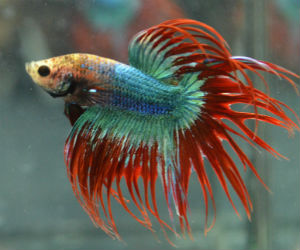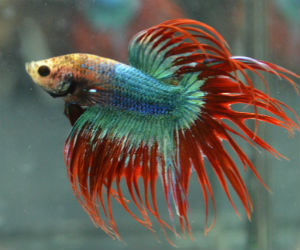
-

Crowntail Fighter Crowntail Fighting Fish all feature an elongated body, a superior mouth and a labyrinth organ with torn looking fins that makes it a bit more fancy than a standard siamese fighter.
Fighting Fish’s natural habitat is slow moving streams or lakes that are heavily vegetated. It is very beneficial for these fish to replicate the tank environment in a similar manner. Although Fighters do have the ability to survive in a small jar, they would much prefer to thrive in a small planted tank with minimal filtration.
SUITABLE TANK MATES
- Most Tropical Fish – I don’t recommend with Neon Tetras (Fighters eat them) or Male Guppies (they can mistake a guppy for another fighter – especially larger flowing tail varieties) or of course Barbs (fin nippers.) Also note Fighters can be an easy target for other fish due to their long fins, so be observant to notice if your fighter is being picked on. If he is hiding a lot generally the result of bullying.
- Dwarf Cichlids
- Goldfish
DIET
Fighting Fish are primarily carnivores – in the wild they will eat surface dwelling insects and larvae, zooplankton and small crustaceans.
We sell specially made fighter pellets to replicate their requirements that are made from a combination of mashed shrimp meal, wheat flour, fish meal, brine shrimp, bloodworms, and vitamins. These seem to work very well and I highly recommend them.
Occasionally we come across a fighter that won’t accept the fighter pellets and instead offer them bloodworms which should be greedily feasted on.
SEXING AND BREEDING
Sexing Fighting Fish is fairly simple. Males generally are very colourful have the large “flowing” tail and a more assertive behavior. Females are a very average looking fish with very short finnage and are not aggressive at all.
Breeding Fighters is tricky but certainly achievable. In the tank you intend to breed in add and condition a mature female for a couple of weeks with brine shrimp or bloodworm.
The temperature of the breeding tank should be around 26-27°C (79-81°F) with PH around neutral.
When you think the female looks ready add a male to the tank.
Turn off the filter or slow it down to minimum flow (if it allows it.) This way the flow will not disturb the bubble nest. Add some floating plants.
It is quite humorous and entertaining watching the normally lethargic male fighter suddenly come to life and get busy and build his bubble nest .
Instantly he visits the top of the aquarium and will start suck in air from the surface then move under the nest and blow bubbles. When a layer of bubbles has been made he will proceed to collect bits of stem and leaves and stick them into his nest of bubbles. This strengthens the structure.
Once he is satisfied he trundles off back to the female and tries to capture her attention by swimming around the female with flared fins, attempting to draw her to the nest where he will continue his courting display.
If she accepts the invitation she will follow him to below the nest and commonly the fish will swim head to tail in a circle in a courting routine.
When she is ready to spawn she touches the male on either the back or the tail with her mouth. Upon this signal the male will embrace the female, turning her first on her side and finally on her back before the female will release approximately 60-80 clear eggs.
The eggs are immediately fertilized by the male. Most of the eggs will float up into the bubblenest. Eggs that stray are collected by the male and placed in the nest. They will spawn again several more times releasing a total of 600 or so eggs.
When the spawning has finished remove the female as she will proceed to eat the eggs – which will infuriate the male. Be careful not to disturb the nest full of eggs. He will kill her if she is left in there.
After 24 hours the eggs begin to hatch and you might notice some tiny little wrigglers. After the third day the wrigglers will look to move away from the nest and this is the time that the male should be removed as he will possibly eat the young.
Raise the young on baby brine shrimp until they are big enough to accept crushed up flake food (perhaps 2-3 weeks.)
OTHER USEFUL INFORMATION
In most states of Australia the fighting fish will be fine with little or no heating for much of the year. However if you find the Fighter stops eating, then that might be a clear indication that the temperature of the water is too cold.
In the cooler months we recommend taking some steps to warm the water slightly to keep your fighting fish happy and long-lived. Ideally the temperature should stay above 18°C – but a temperature of around 24°C would be preferred.
The easiest way would be to add an aquarium heater to the setup (we sell specially made smaller 8W heaters for fighter or goldfish bowls) or a normal glass heater would suffice for an aquarium setup.
Other options include a heat mat placed below a bowl, or moving the fish into the warmest room in the house, turning the heating up in your house, I have even had one customer who had great success wrapping the bowl up in a towel !! 🙂
9 times out of 10 you can keep your fighter in a community setup. I have plenty of customers who keep them with goldfish or other tropical fish.
Common Name(s) : Crowntail Fighting Fish
Family : Osphronemidae
Genus: Betta
Species : Betta splendens
Origin : Asia – Thailand, Cambodia and Malaysia
PH : 6.5 – 7.5
Hardness : Soft to Moderately Hard
Temperature : 18 – 28°C / 64.4–82°F
Maximum Size : 7-8cm / 2.7-3.1″
Lifespan : 3.5 years
Aggression Level : Medium-High (5.5/10) (Only males are aggressive to other males)
Recommended Tank Size : 1 Litre +
Strata : Middle – Top
I have added an excellent youtube video of fighters breeding for your viewing pleasure.
